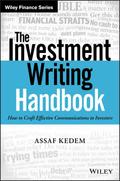The Investment Writing Handbook
How to Craft Effective Communications to Investors
Wiley Finance Editions

1. Auflage März 2018
224 Seiten, Hardcover
Wiley & Sons Ltd
The writing "bible" for financial professionals
The Investment Writing Handbook provides practical, accessible guidance for crafting more effective investor communications. Written by an award-winning writer, editor, and speechwriter, this book explains the principles and conventions that help writing achieve its purpose; whether you need to inform, educate, persuade, or motivate, you'll become better-equipped to develop a broad range of communications and literature for investor consumption. Examples from real-world financial institutions illustrate expert execution, while explanations and advice targeted specifically toward investor relations give you the help you need quickly. From white papers and investment commentary to RFPs, product literature, and beyond, this book is the financial writer's "bible" that you should keep within arm's reach.
Investment writing is one of the primary influences on investors' attitudes. It educates, informs decisions, shapes opinions, and drives behavior--so shouldn't it be expertly-crafted to achieve its intended goal? This book explains the "tricks of the trade" to help you get your message across.
* Understand the principles of effective investor communication
* Master the conventions of informative and persuasive writing
* Examine well-written sample documents from real-world institutions
* Improve research papers, presentations, investor letters, marketing literature, and more
Virtually all firms with investors as clients need to communicate to them regularly, but few financial professionals receive formal training in investor communications. When investors' opinions, attitudes, and actions determine the health of your company, it is vitally important that these communications not be left to chance. The Investment Writing Handbook provides essential guidance and clear explanations to help you transform your communication strategy, execution, and results.
Introduction: For Whom Is This Handbook, and Why? xiii
Acknowledgments xv
About the Author xvii
CHAPTER 1 The Building Blocks of Investment Writing 1
What's Investment Writing All About? 1
Applying Journalistic Principles to Investment Writing 2
The Five Ws and the Pyramid Principle 3
Inquisitiveness 4
Proactive Idea Generation 6
The Strategic Purposes of Investment Writing 7
Note 8
CHAPTER 2 Writing for Investor Acquisition and Retention 9
Framing Your Investment Proposition as the Solution to a Problem 11
Step 1: Define Your Offering 12
Step 2: Identify Your Client's Problem 12
Step 3: Acknowledge the Problem 14
Step 4: Frame Your Offering to Address the Investor's Concerns 14
Investor Retention: It's All in the Communication 15
Opportunities for Retentive Communications 17
Facts Are Key for Reassuring Your Investors 19
Other Considerations for Reassuring Investors 27
Notes 31
CHAPTER 3 Writing for Intermediaries 33
How Intermediaries Expect You to Communicate 34
Communicate on a Consistent Basis 34
Crystallize the Details of Your Firm's Offerings 35
Provide Timely, Turnkey Investment Literature 35
Keep Your Communications Targeted 37
Intermediaries Don't Have It Easy, So Help Them Out 38
CHAPTER 4 Stylistic Considerations for Investment Writing 39
Setting the Appropriate Style 41
The Desired Image and Voice an Investment Firm or Professional Wishes to Project 42
The Type of Literature Being Written 43
The Investor's Presumed Knowledge about the Subject Matter 47
On Using Jargon 48
Refrain from Explaining Certain Jargon to Highly Sophisticated Investors 49
Distinguish Between the Three Broad Levels of Investment Literacy 50
Alternatives to Explaining Jargon 52
Cut Through Extraneous Technical Detail 53
If You Risk Being Vague, Err on the Side of Clarity 54
Introduce Fresh Alternatives to Trite Jargon 56
Be Discerning about Nuance 58
Use Plain Language--Even If It's Technical 62
Piquing Investors' Interest 64
Forge a Compelling Storyline for Your Piece 64
Craft Alluring Headlines 64
Incorporate Storytelling and Anecdotes 66
Animate Your Writing with Quotations, Metaphors, and Other References 66
The Value of a Style Guide for Investment Writing 67
Key Areas to Cover in Your Firm's Style Rules 68
Syntax, Wording, and Formatting 68
First-Person Pronouns and Possessives 69
Chart Labeling 70
International Considerations 70
Inessential Words 71
Cumbersome Constructions 72
Legal Considerations 72
Tone 73
Principles for Creating Scannable Copy 75
Addressing Common Language Mistakes 75
A Parting Note on Style 76
Notes 76
CHAPTER 5 Developing an Architecture of Investment Content 77
Part 1: Foundational Literature 78
Firm-Overview and Investment-Capabilities Brochures 78
Strategy and Product Profiles 84
Packaging Your Strategy or Product Profile with Other Literature 107
RFP Responses 107
Pitch Books 114
Case Studies 117
Topical Brochures 121
Concluding Foundational Literature with a Call to Action 126
Part 2: Intellectual Capital 126
The Strategic Use of Intellectual Capital 127
The Elements of Intellectual Capital 131
The Packaging of Intellectual Capital 132
The Process of Writing Long-Form Literature 140
Part 3: Educational Literature 144
Part 4: Digital and Social Media 147
Part 5: Shareholder Communications 149
Fund-Performance Commentary 150
Now That You've Mapped Architecture... 152
Notes 153
CHAPTER 6 How to Simplify Complex Investment Subjects 155
Think Bits--Not Pieces 155
Visualize the Idea for Your Readers 157
Start with a Preamble 158
Lay Out a Table 160
Use a Frame of Reference, Analogy, or Metaphor 160
Give an Example 162
Note 162
CHAPTER 7 How to Make Investment Writing Legally Compliant 163
Avoid Absolutes, Superlatives, and Definitive Statements... 165
You Can Be Predictive--But Not Promissory 167
Be Specific Enough for Clarity--Yet General Enough to Accommodate Exceptions 170
Time-Stamp Anything That's Impermanent 171
Cherries Are Not for Picking--and Securities Come at a Price 171
Negotiate Gray Areas with Your Legal Reviewer 172
Use Caution When Navigating Word Subtleties 174
Avoid Redundant Qualifications 174
Unless You're Permitted, Do Not Dispense Investment Advice 175
Social (Media) Butterflies Are Not Exempt from Regulatory Requirements 176
Consult a Legal Specialist When Writing about Investment Performance 177
Seek Ways to Streamline the Legal Review 177
Diversify Your Language 178
On Legalities, Creativity, and Integrity 179
Notes 179
Epilogue: Where Investment Writing Is Headed in the Twenty-First Century 181
Index 185


